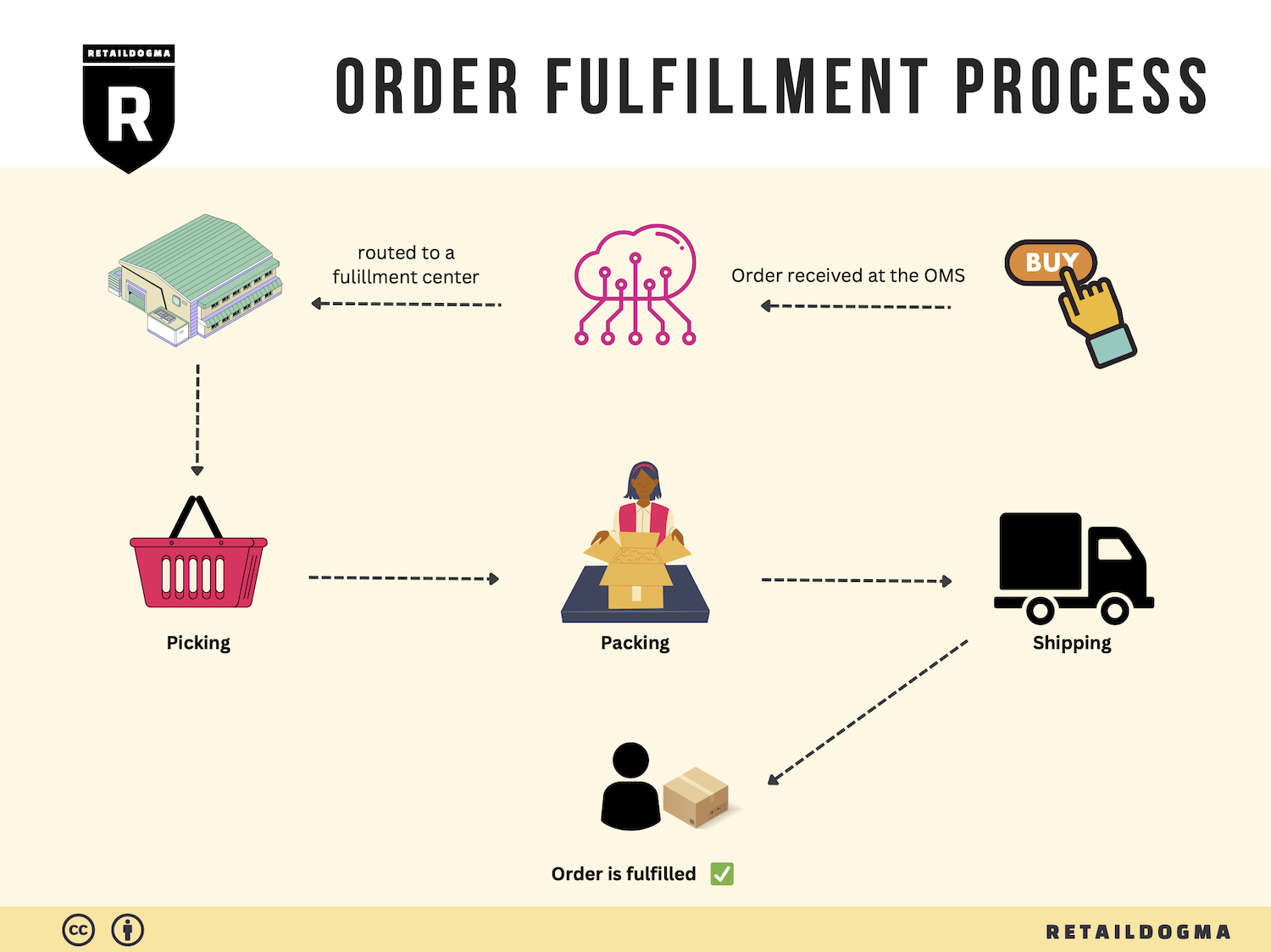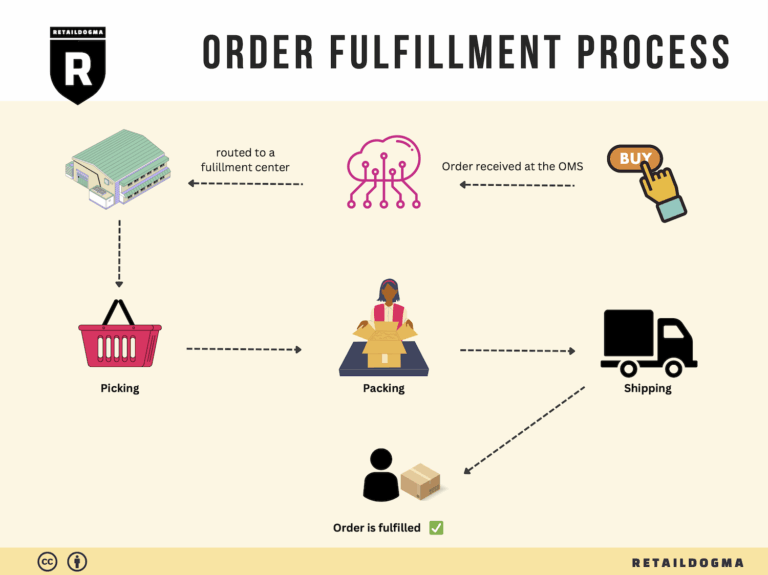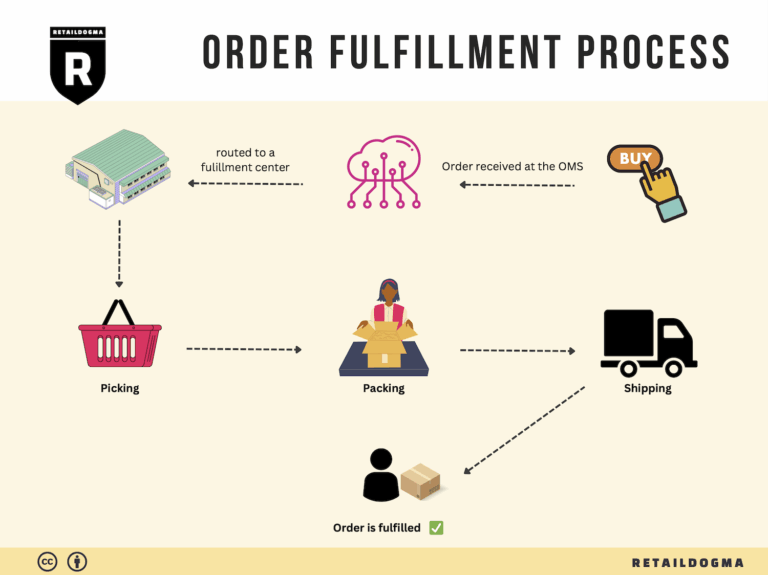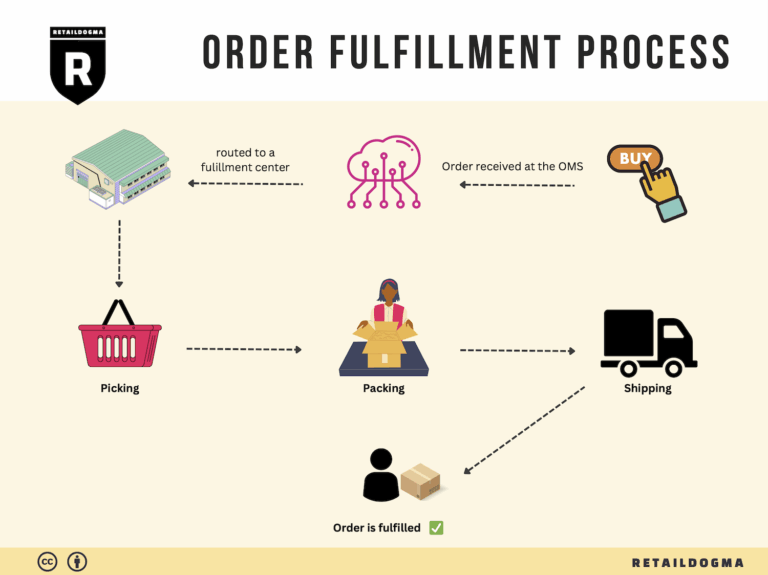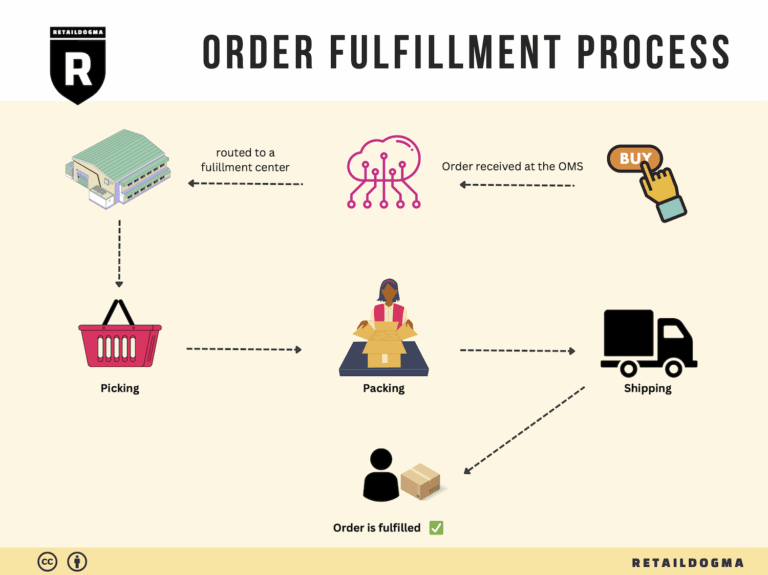How Order Fulfillment Works: A Step-by-Step Guide for Businesses
What is E-commerce Fulfillment? An Introduction for Growing Businesses
As your e-commerce business begins to grow, the excitement of increased sales can quickly turn into the stress of managing logistics. Packing and shipping orders can become an overwhelming task, often diverting your attention from core business activities like marketing and product development. This is where effective e-commerce fulfillment comes into play. At its simplest, fulfillment is the process of getting a product from your warehouse or fulfillment center to your customer’s doorstep. It encompasses everything from inventory management to shipping logistics, and it’s crucial for maintaining customer satisfaction.
In this guide, we will explore the various fulfillment models available to growing businesses, including Third-Party Logistics (3PL) and Fulfillment by Amazon (FBA). Each model has its unique advantages and challenges, and understanding these can help you choose the best option for your business needs.
Core Services of E-commerce Fulfillment
We will delve into the core services typically offered by fulfillment partners, including order processing, inventory management, packing and shipping, and returns handling. These services are designed to streamline operations and enhance the overall customer experience. By outsourcing these tasks, you can focus on scaling your business without the burden of logistical headaches.
Choosing the Right Fulfillment Partner
Selecting the right fulfillment partner is a pivotal decision for your business. This guide will provide you with practical tips on how to evaluate potential partners based on factors such as service offerings, technology integration, scalability, and customer service. We will also discuss the importance of aligning your fulfillment strategy with your business goals.
Understanding Pricing Structures
Pricing can be a complex aspect of e-commerce fulfillment. We will break down common pricing structures, including storage fees, order processing fees, and shipping costs, to help you understand how these factors can impact your bottom line. Knowing what to expect in terms of expenses will empower you to make informed decisions.
Empowering Your Business Decisions
The ultimate goal of this guide is to empower you with the knowledge and tools necessary to make smart decisions about your logistics strategy. Whether you are considering partnering with a 3PL provider or exploring other fulfillment options, having a comprehensive understanding of e-commerce fulfillment will enable you to enhance efficiency, improve customer satisfaction, and foster business growth.
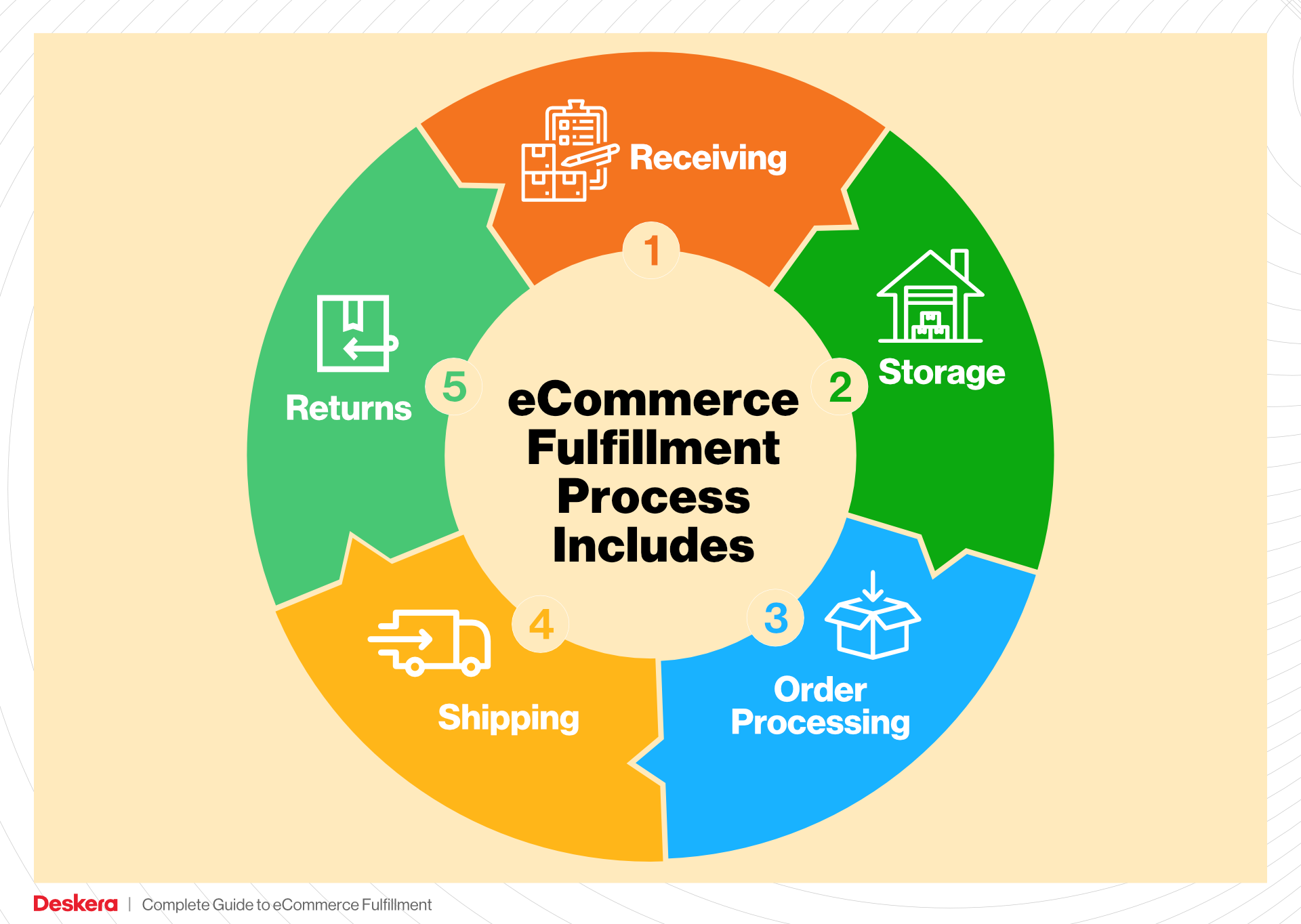
What You’ll Learn In This Guide
- What is E-commerce Fulfillment? An Introduction for Growing Businesses
- The Order Fulfillment Process: From ‘Buy’ Button to Customer’s Door
- Comparing Fulfillment Models: In-House vs. 3PL vs. Dropshipping
- A Deep Dive into Amazon FBA: Pros, Cons, and Who It’s For
- Core Services Offered by Fulfillment Centers
- How to Choose a Fulfillment Partner: A 6-Point Checklist
- Understanding Fulfillment Pricing: A Breakdown of Common Fees
- Frequently Asked Questions (FAQs) about Fulfillment
- Conclusion: Is Outsourcing Fulfillment the Right Move for Your Business?
- Important Disclaimer
The Order Fulfillment Process: From ‘Buy’ Button to Customer’s Door
1. Receiving Inventory
The order fulfillment process begins with receiving inventory at the fulfillment center. This step involves inspecting incoming shipments, verifying that the products match the purchase order, and logging them into the inventory management system. Each item is typically assigned a Stock Keeping Unit (SKU), which is a unique identifier that helps track inventory levels and movements accurately.
Importance: Proper receiving practices are crucial for maintaining inventory accuracy and preventing stock discrepancies. If products are not received correctly, it can lead to issues such as stockouts or excess inventory, both of which can negatively impact sales and customer satisfaction.
Key Term: SKU (Stock Keeping Unit) – A unique identifier assigned to each product to facilitate tracking and inventory management.
2. Warehouse Storage
Once inventory has been received and verified, it is stored in the warehouse. This involves organizing products in a way that maximizes space and efficiency while ensuring easy access for future order fulfillment. Products may be stored on shelves, in bins, or in designated areas based on their size, weight, and demand.
Importance: Efficient warehouse storage directly impacts the speed of order fulfillment. A well-organized storage system reduces the time it takes to find and retrieve products, enabling faster order processing. Additionally, effective inventory management minimizes the risk of overstocking or understocking items.
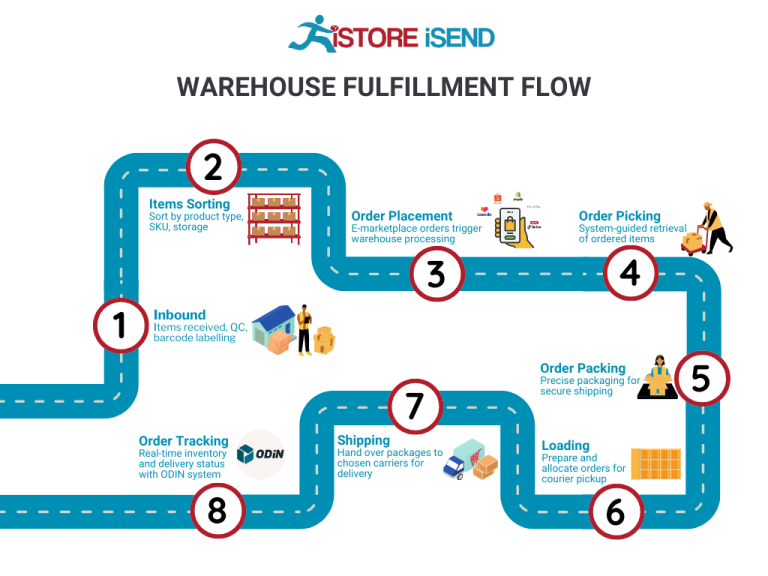
Key Term: ABC Analysis – A method used to categorize inventory based on its importance, often determined by sales volume or value, to optimize storage and management efforts.
3. Order Picking
Order picking is the process where warehouse staff select items from storage to fulfill customer orders. This can be done using various methods, such as single order picking, batch picking, or wave picking, depending on the volume and nature of the orders. A pick list—an organized list of items needed for each order—is typically generated to guide the picking process.
Importance: The accuracy of order picking is critical to customer satisfaction. Errors in picking can lead to incorrect shipments, resulting in returns and dissatisfaction. Efficient picking processes can significantly reduce order fulfillment time and enhance overall operational efficiency.
Key Term: Pick List – A document or digital tool that outlines the items and quantities to be picked for each order, facilitating an organized and efficient picking process.
4. Order Packing
After items have been picked, they are packed for shipping. This step involves selecting appropriate packaging materials to protect the products during transit and ensuring that the packing is efficient to minimize shipping costs. Packing also includes labeling the packages with shipping information and any necessary documentation.

Importance: Proper packing is essential not only for protecting the products but also for optimizing shipping costs. Well-packed orders reduce the risk of damage during transit, ensuring that customers receive their products in perfect condition. Additionally, effective packing can enhance the unboxing experience, contributing to customer satisfaction and loyalty.
Key Term: Dimensional Weight Pricing – A shipping cost calculation method that considers both the weight and dimensions of a package, influencing how items should be packed for cost-effective shipping.
5. Shipping & Delivery
The final step in the order fulfillment process is shipping and delivery. Once orders are packed, they are handed over to shipping carriers for delivery to the customer. This involves selecting the best shipping options based on cost, speed, and destination. Tracking information is usually provided to customers, allowing them to monitor their shipment in real time.
Importance: Timely and accurate shipping is critical for maintaining customer trust and satisfaction. Delays or issues in delivery can lead to negative experiences and impact repeat business. Moreover, providing tracking information enhances transparency and keeps customers informed about their order status.
Key Term: Last-Mile Delivery – The final step of the shipping process where the package is delivered from a distribution center to the final destination, which is often the most complex and costly part of the shipping journey.
By understanding and optimizing each step of the order fulfillment process, e-commerce businesses can enhance their operational efficiency, improve customer satisfaction, and ultimately drive growth in sales. Adopting best practices at each stage ensures that products move swiftly from the ‘buy’ button to the customer’s door, creating a seamless shopping experience.
Comparing Fulfillment Models: In-House vs. 3PL vs. Dropshipping
Fulfillment Model Comparison
| Model | Who Handles Inventory | Best For (Business Stage) | Key Advantage | Key Disadvantage |
|---|---|---|---|---|
| In-House Fulfillment | The business itself | Startups to Established | Full control over operations | High overhead costs and complexity |
| Third-Party Logistics (3PL) | A third-party provider | Growing to Established | Scalability and reduced operational burden | Less control over inventory and processes |
| Dropshipping | Supplier or manufacturer | Startups to Small Businesses | Low upfront investment | Lower profit margins and potential delays |
In-House Fulfillment
In-house fulfillment refers to the process where a business manages its own warehousing, inventory management, and order processing. This model allows companies to maintain complete control over their logistics operations, ensuring that they can tailor processes to their specific needs and branding. For startups and established businesses alike, in-house fulfillment can provide a competitive edge, particularly in terms of quality control and customer service. Businesses can implement personalized packaging, offer faster shipping options, and have direct oversight of inventory levels. However, the in-house model comes with significant challenges. The costs associated with warehousing, staff, and technology can be substantial, especially for smaller businesses. Additionally, as order volumes increase, managing logistics can become complex, requiring sophisticated systems and processes that may not be feasible for every business.
Third-Party Logistics (3PL)
Third-party logistics (3PL) providers offer a comprehensive suite of logistics services to businesses, including warehousing, order processing, and shipping. This model is ideal for growing businesses that want to focus on core operations like product development and marketing without the burden of managing logistics in-house. By leveraging a 3PL, businesses can scale their operations quickly and efficiently, as these providers typically have established networks, advanced technology, and expertise in inventory management and shipping. A major advantage of using 3PL services is the flexibility they provide; businesses can adjust their logistics needs based on seasonal demand or growth without committing to long-term investments in infrastructure. However, the downside is that businesses may lose some control over their inventory and fulfillment processes, which can lead to inconsistencies in customer experience. Additionally, the costs associated with 3PL services can vary significantly based on order volume and specific service requirements, making it crucial for businesses to carefully evaluate their options.
Dropshipping
Dropshipping is a fulfillment model where the retailer does not keep products in stock but instead transfers customer orders directly to a supplier or manufacturer, who then ships the products to the customer. This model is particularly attractive for startups and small businesses because it requires minimal upfront investment and eliminates the need for warehousing and inventory management. Entrepreneurs can offer a wide range of products without the risk associated with holding inventory, making it easier to test new products and markets. However, dropshipping also comes with its own set of challenges. The most significant disadvantage is the lower profit margins compared to traditional retailing, as suppliers often set prices that leave little room for mark-up. Furthermore, reliance on third-party suppliers can result in longer shipping times and quality inconsistencies, which can negatively impact customer satisfaction. Managing customer expectations is crucial in this model, as delays in shipping or issues with product quality can lead to negative reviews and lost sales.
Conclusion
Choosing the right fulfillment model is critical for e-commerce businesses aiming to scale effectively. Each model—In-House Fulfillment, 3PL, and Dropshipping—has its unique advantages and challenges. In-house fulfillment offers control and customization but at a higher cost and complexity. 3PL providers present a scalable solution that allows businesses to focus on growth while outsourcing logistics, though it may come with less control over inventory. Dropshipping is an appealing low-investment option for new businesses, but it can lead to lower profits and customer dissatisfaction if not managed properly. Ultimately, the decision should align with the business’s goals, resources, and growth trajectory.
A Deep Dive into Amazon FBA: Pros, Cons, and Who It’s For
Understanding Fulfillment by Amazon (FBA)
Fulfillment by Amazon (FBA) is a service offered by Amazon that enables e-commerce sellers to leverage Amazon’s extensive logistics network for their fulfillment needs. By using FBA, sellers can store their products in Amazon’s fulfillment centers, and Amazon takes care of the storage, packaging, shipping, and customer service for these products. This service allows sellers to focus on growing their business while benefiting from Amazon’s robust infrastructure.
When a customer orders a product through Amazon, the item is picked, packed, and shipped directly from Amazon’s fulfillment center. Amazon also handles returns, making the process seamless for sellers and customers alike. Additionally, products fulfilled through FBA are eligible for Amazon Prime, which can significantly increase sales due to the appeal of fast, free shipping.
How FBA Works
-
Product Listing: Sellers create product listings on Amazon and choose which products to fulfill through FBA.
-
Inventory Shipment: Sellers send their products to Amazon’s fulfillment centers. Amazon provides guidance on how to prepare and package the products for shipment.
-
Storage: Once the products arrive at the fulfillment center, they are stored until sold. Amazon manages the inventory, ensuring optimal organization and accessibility.
-
Order Fulfillment: When a customer places an order, Amazon’s system automatically picks the product from the inventory, packages it, and ships it to the customer.
-
Customer Service: Amazon handles all customer service inquiries related to FBA products, including returns and refunds, allowing sellers to focus on other aspects of their business.
Pros of Using FBA
1. Prime Eligibility
One of the most significant advantages of using FBA is that products become eligible for Amazon Prime. This not only enhances the product’s visibility but also attracts customers who prioritize fast and free shipping. The Prime badge can lead to higher conversion rates and increased sales.
2. Customer Trust
Amazon is a trusted platform, and customers often feel more secure purchasing items fulfilled by Amazon. The reliability of Amazon’s shipping and customer service can lead to increased buyer confidence, which is crucial for new sellers or those looking to expand.
3. Multi-Channel Fulfillment
FBA isn’t limited to just Amazon sales; sellers can use FBA to fulfill orders from other platforms, such as their own e-commerce sites or eBay. This multi-channel fulfillment capability allows sellers to streamline their logistics operations and manage inventory more efficiently.
4. Simplified Logistics
By outsourcing fulfillment to Amazon, sellers can alleviate the complexities involved in warehousing, shipping, and customer service. This can lead to a more straightforward operational model, allowing sellers to focus on product development and marketing strategies.
5. Access to Advanced Tools
FBA users gain access to Amazon’s suite of selling tools, including analytics and reporting, which can provide valuable insights into sales performance and inventory management. These tools can help sellers make informed decisions to optimize their business.
Cons of Using FBA
1. High Fees
While FBA offers numerous benefits, the service comes with costs. Sellers are charged for storage and fulfillment, which can add up quickly, especially for businesses with low margins or slow-moving inventory. Understanding and managing these fees is essential to maintain profitability.
2. Strict Inventory Rules
Amazon has stringent guidelines regarding inventory management, including how products should be packaged and labeled. Non-compliance can lead to additional fees or even removal of inventory. This can be a burden for sellers who are not familiar with Amazon’s policies.
3. Commingling Risks
FBA products may be commingled, meaning that inventory from different sellers is stored together. This can lead to issues if a customer receives a product that is not from the expected seller, potentially damaging a seller’s reputation. Some sellers prefer to opt-out of commingling to maintain control over their inventory.
4. Limited Control Over Fulfillment
When utilizing FBA, sellers relinquish some control over the fulfillment process. This includes how products are packaged and shipped, which may not align with a seller’s branding or customer experience goals.
5. Inventory Limits
Amazon imposes limits on the amount of inventory a seller can send to its fulfillment centers, especially for new sellers or those with low sales velocity. This can restrict growth and create challenges for scaling operations.
Who is FBA Best For?
Fulfillment by Amazon is best suited for e-commerce businesses looking to scale quickly without the hassle of managing their logistics. It’s ideal for:
- New Sellers: Those just starting out can benefit from Amazon’s established infrastructure and customer trust.
- High-Volume Sellers: Businesses with a steady stream of sales can leverage FBA to maximize efficiency and reduce shipping times.
- Brands Seeking Growth: Companies looking to expand their reach through Amazon’s platform will find FBA invaluable due to its Prime eligibility and customer service capabilities.
- Multi-Channel Sellers: Businesses that sell on multiple platforms can simplify their operations by using FBA for all their fulfillment needs.
In summary, FBA can be a powerful tool for e-commerce sellers who are ready to take advantage of Amazon’s logistics capabilities, provided they are prepared to navigate the associated costs and regulations. Understanding both the pros and cons can help sellers make informed decisions about whether FBA aligns with their business goals.
Core Services Offered by Fulfillment Centers
Inventory Management & Warehousing
Inventory management and warehousing are foundational services provided by fulfillment centers that directly impact an e-commerce business’s operational efficiency. At its core, inventory management involves tracking stock levels, orders, sales, and deliveries. Fulfillment centers utilize advanced technology to monitor inventory in real-time, ensuring that e-commerce businesses have up-to-date visibility of their stock.
The benefits of effective inventory management include minimizing stockouts and overstock situations, which can lead to lost sales or increased holding costs. With precise inventory tracking, businesses can make informed decisions regarding reordering and stock levels, enabling them to respond swiftly to market demand. Additionally, fulfillment centers often provide warehousing solutions that optimize space utilization, reduce costs associated with maintaining a physical location, and ensure that products are stored under optimal conditions, reducing the risk of damage.
Pick and Pack Services
Pick and pack services are crucial for the smooth operation of order fulfillment processes. This service involves selecting items from the warehouse (picking) and then packaging them securely for shipment (packing). Fulfillment centers employ systematic processes and technologies to streamline this operation, ensuring that orders are filled accurately and efficiently.
The primary benefit of pick and pack services is the speed and accuracy with which orders are processed. By leveraging automation and trained staff, fulfillment centers can significantly reduce order processing times, which is critical for meeting customer expectations in today’s fast-paced e-commerce landscape. Faster order fulfillment leads to increased customer satisfaction and loyalty, as consumers increasingly demand quick delivery times. Additionally, a well-executed pick and pack operation minimizes errors, reducing the likelihood of returns and enhancing overall operational efficiency.
Kitting and Assembly
Kitting and assembly services involve the grouping of individual items into ready-to-ship sets or kits, which may require some level of assembly before shipping. This service is particularly beneficial for e-commerce businesses that sell products that are often bundled together, such as subscription boxes or promotional kits.
The advantage of kitting and assembly services lies in their ability to enhance the customer experience and streamline the fulfillment process. By pre-assembling kits, businesses can offer more attractive product options and improve inventory turnover. Additionally, having kits ready to ship can significantly reduce order processing times, as fulfillment centers can quickly grab pre-packaged items rather than assembling them on demand. This service also provides e-commerce businesses with the flexibility to tailor offerings to seasonal promotions or customer preferences, ultimately boosting sales and customer satisfaction.
Returns Management (Reverse Logistics)
Returns management, often referred to as reverse logistics, is an essential service offered by fulfillment centers that focuses on handling product returns efficiently. This process includes receiving returned items, inspecting them for damage, restocking them if possible, and managing the associated paperwork and customer communication.
The benefits of effective returns management cannot be overstated in the e-commerce world, where return rates can be significantly higher than in traditional retail. A streamlined returns process can enhance customer trust and satisfaction, as consumers are more likely to make a purchase if they know they can easily return items if needed. Furthermore, fulfillment centers can analyze return data to identify trends and issues with products, allowing e-commerce businesses to address customer concerns proactively and improve product quality.
In summary, fulfillment centers provide a suite of core services that are integral to the success of e-commerce businesses. By leveraging advanced technology and expertise in logistics, these centers enable businesses to manage their inventory effectively, process orders quickly, create appealing product offerings through kitting, and manage returns seamlessly. As e-commerce continues to grow, partnering with a reliable fulfillment center can be a game-changer for businesses looking to scale operations and enhance customer satisfaction.
How to Choose a Fulfillment Partner: A 6-Point Checklist
Location & Warehouse Network
Importance: The geographical location of your fulfillment partner’s warehouses can significantly impact shipping times and costs. A well-placed network can facilitate faster deliveries to your customer base, enhancing customer satisfaction.
Questions to Ask:
– Where are your fulfillment centers located, and how do these locations align with my target market?
– What is your shipping range, and do you offer international shipping?
– How do you manage shipping costs, and can you provide options for expedited shipping?
Technology & Integrations
Importance: In today’s digital landscape, the technology your fulfillment partner uses can streamline operations and improve efficiency. Seamless integration with your e-commerce platform allows for real-time inventory updates, order tracking, and data analytics.
Questions to Ask:
– What technology platforms do you use for inventory management and order processing?
– How do you integrate with popular e-commerce platforms (e.g., Shopify, WooCommerce)?
– Can your system support real-time tracking for orders, and how does it handle updates?
Specializations (e.g., Cold Storage, Oversized Items)
Importance: Depending on the nature of your products, you may require specific services such as temperature-controlled storage for perishables or handling oversized items. Choosing a 3PL with the right specializations can prevent costly errors and ensure compliance with regulations.
Questions to Ask:
– Do you offer specialized services for my product type (e.g., cold storage, fragile items, oversized goods)?
– What experience do you have in handling products similar to mine?
– How do you ensure compliance with industry standards for specialized storage?
Scalability & Capacity
Importance: As your business grows, your fulfillment needs will likely change. A fulfillment partner that can scale with your business can help you avoid disruptions and additional costs associated with switching providers.
Questions to Ask:
– What is your current capacity, and how do you handle peak seasons or unexpected surges in orders?
– Can you provide examples of how you have scaled operations for other clients?
– What is your process for onboarding new clients and ramping up fulfillment capabilities?
Pricing and Contracts
Importance: Understanding the pricing structure and contract terms is crucial for budgeting and financial planning. Transparent pricing helps you avoid unexpected costs and ensures you are getting value for the services provided.
Questions to Ask:
– Can you provide a detailed breakdown of your pricing model (e.g., storage fees, pick and pack costs, shipping rates)?
– Are there any hidden fees or additional charges I should be aware of?
– What are the terms of your contract, and is there flexibility for adjustments as my business grows?
Customer Support & Reviews
Importance: Reliable customer support is essential for resolving issues quickly and maintaining a smooth operation. Additionally, reviews and testimonials can provide insights into the partner’s reliability and service quality.
Questions to Ask:
– What type of customer support do you offer (e.g., dedicated account manager, 24/7 support)?
– How do you handle issues such as order errors or shipping delays?
– Can you provide references or case studies from current or past clients?
Conclusion
Choosing the right fulfillment partner is a critical decision that can impact your e-commerce operations and customer satisfaction. By utilizing this checklist, you can systematically evaluate potential 3PL providers and make an informed choice that aligns with your business goals. Remember, the right partner should not only meet your current needs but also support your growth and adaptability in an ever-evolving market.
Understanding Fulfillment Pricing: A Breakdown of Common Fees
Initial Setup Fees
When partnering with a third-party logistics (3PL) provider, businesses often encounter initial setup fees. These fees cover the costs associated with onboarding your account, integrating your e-commerce platform with the 3PL’s systems, and configuring your inventory management settings. The initial setup can include the following components:
- Account Creation: Establishing your account within the 3PL’s system, which may involve a one-time fee.
- Software Integration: Costs related to integrating your e-commerce platform (such as Shopify, WooCommerce, or Amazon) with the 3PL’s fulfillment software.
- Inventory Setup: Fees for entering product data and organizing your inventory in the fulfillment center.
These fees can vary widely depending on the complexity of your operations and the specific services the 3PL offers, ranging from a few hundred to several thousand dollars.
Receiving Fees
Receiving fees are charged when your inventory arrives at the fulfillment center. This fee covers the labor and resources required to unload, inspect, and store your products. The calculation of receiving fees typically depends on:
- Volume of Goods: The number of pallets or boxes being received. Larger shipments may incur higher fees due to the increased handling time.
- Type of Products: Special handling requirements (such as fragile or oversized items) can lead to higher receiving fees.
- Labor Costs: The time and resources needed for inspection and organization of inventory once it arrives.
Businesses should anticipate these fees as part of their cost structure when managing inventory replenishment.
Storage Fees (per pallet/bin)
Storage fees are charged for the space your products occupy within the fulfillment center. This fee is typically calculated on a per-pallet or per-bin basis and may be assessed monthly. Key factors influencing storage fees include:
- Storage Duration: The longer your inventory remains in the warehouse, the higher the costs. Some 3PLs may offer tiered pricing based on the length of time items are stored.
- Space Utilization: Efficiently utilizing storage space can help minimize fees. Some providers charge based on cubic feet, while others may use pallet counts.
- Seasonality: If you experience seasonal fluctuations in inventory, be aware that storage fees may increase during peak seasons when demand for space rises.
Understanding your storage needs and planning for fluctuations can help you manage these costs effectively.
Pick & Pack Fees (per item/order)
Pick and pack fees are charged for the labor involved in selecting items from storage and preparing them for shipment. These fees can vary based on several factors:
- Number of Items: Fees may be calculated per item or per order. For instance, an order with multiple items may incur higher fees due to the increased picking time.
- Complexity of Orders: Custom packing requirements (such as special packaging or kitting) can increase labor time and, consequently, the fees.
- Automation: Some 3PLs utilize automated systems that can reduce pick and pack fees, while others may rely heavily on manual labor.
Understanding your typical order sizes and complexities can help you estimate these costs more accurately.
Shipping Fees
Shipping fees are among the most variable costs in fulfillment pricing. These fees are influenced by multiple factors, including:
- Shipping Method: Different carriers (UPS, FedEx, USPS, etc.) and shipping speeds (standard, expedited, etc.) will have varying rates.
- Destination: Shipping costs can significantly differ based on whether the destination is local, national, or international.
- Weight and Dimensions: Carriers often charge based on the weight and size of the package. Dimensional weight pricing may apply, meaning larger but lighter packages could incur higher costs.
To optimize shipping costs, businesses should consider negotiating rates with carriers or leveraging the 3PL’s existing partnerships for better pricing.
Tips for Getting an Accurate Quote
To ensure you receive an accurate fulfillment pricing quote from a 3PL, consider the following tips:
- Provide Detailed Information: Share specifics about your product types, average order sizes, and expected volumes to help the 3PL tailor their quote.
- Ask About All Fees: Inquire about each fee type, including any potential hidden costs, to avoid surprises later.
- Understand Pricing Models: Familiarize yourself with different pricing structures (fixed vs. variable) and how they may impact your overall costs.
- Request a Trial Period: If feasible, negotiate a trial period to assess the 3PL’s services and pricing before committing long-term.
- Compare Multiple Quotes: Don’t settle for the first quote you receive. Comparing multiple providers can help you identify the best fit for your business needs.
By following these guidelines, you can navigate the complexities of fulfillment pricing and make informed decisions that support your e-commerce growth.
Frequently Asked Questions (FAQs) about Fulfillment
1. What is 3PL e-commerce fulfillment?
3PL e-commerce fulfillment refers to the outsourcing of logistics and supply chain management to a third-party provider. These companies handle various tasks, including warehousing, inventory management, order processing, packing, shipping, and returns management, allowing e-commerce businesses to focus on their core operations.
2. How does a fulfillment center differ from a warehouse?
While both fulfillment centers and warehouses store goods, their functions differ significantly. A fulfillment center is designed for fast-paced operations where products are received, picked, packed, and shipped to customers frequently. In contrast, a warehouse primarily serves as a long-term storage solution with less frequent movement of goods.
3. What services do 3PL companies provide?
3PL companies offer a comprehensive range of services including inventory management, order processing, pick and pack operations, shipping, freight forwarding, customs clearance, returns handling, and technology integration for seamless operations. This allows businesses to streamline their logistics and enhance customer satisfaction.
4. How much do fulfillment services cost?
The cost of fulfillment services varies widely based on factors such as order volume, storage space required, weight and dimensions of products, and specific services needed (like returns management or kitting). Businesses typically receive customized pricing quotes after discussing their specific requirements with a 3PL provider.
5. What are the benefits of using a 3PL fulfillment company?
Utilizing a 3PL fulfillment company can significantly reduce overhead costs, improve efficiency, and enhance customer service. By outsourcing logistics, businesses can scale operations, access advanced technology for inventory management, and benefit from the expertise of logistics professionals without the need for significant investment in infrastructure.
6. How can I choose the right 3PL partner for my e-commerce business?
Choosing the right 3PL partner involves evaluating several factors: the provider’s experience in your industry, the range of services offered, technology integration capabilities, scalability, pricing structure, and customer service reputation. It’s essential to conduct thorough research and request proposals from multiple providers to compare offerings.
7. What is the role of technology in 3PL fulfillment?
Technology plays a crucial role in 3PL fulfillment by enabling real-time inventory tracking, order management, and analytics. Advanced software systems allow for seamless integration with e-commerce platforms, automate various processes, and provide data insights that help businesses make informed decisions about their supply chain.
8. Can 3PL companies handle international shipping?
Yes, many 3PL companies specialize in international shipping and can manage customs clearance, documentation, and freight forwarding services. They often have established relationships with global carriers, allowing them to offer competitive rates and efficient service for international orders.
9. What is kitting, and how can it benefit my e-commerce business?
Kitting is the process of assembling individual items into ready-to-ship sets or kits. This service can streamline order fulfillment, reduce shipping costs, and enhance the customer experience by providing products in a convenient package. 3PL providers often offer kitting as part of their fulfillment services.
10. How can 3PL fulfillment improve customer satisfaction?
3PL fulfillment can enhance customer satisfaction by ensuring faster and more accurate order processing, providing reliable shipping options, and managing returns efficiently. By outsourcing logistics to experts, e-commerce businesses can focus on improving their product offerings and marketing strategies, ultimately leading to a better customer experience.
Conclusion: Is Outsourcing Fulfillment the Right Move for Your Business?
Evaluating the Benefits of Outsourcing Fulfillment
As e-commerce continues to evolve, outsourcing fulfillment can offer significant advantages for businesses aiming to scale efficiently. One of the primary benefits is time savings. By delegating inventory management, order processing, and shipping to a third-party logistics (3PL) provider, you can focus on strategic initiatives such as marketing, product development, and customer engagement. This allows you to allocate resources more effectively and drive growth without getting bogged down in operational details.
Scalability is another compelling reason to consider a fulfillment partner. As your business grows, so do your logistics needs. A reliable 3PL can adapt to fluctuations in order volume and seasonal demand, providing the flexibility necessary to meet customer expectations without the need for significant capital investment in warehousing or staffing. This agility can be a game-changer, especially in a competitive e-commerce landscape.
Furthermore, partnering with a fulfillment service brings expertise that may be lacking in-house. Fulfillment companies specialize in logistics and supply chain management, offering insights and technology that can enhance efficiency and accuracy. They often have established relationships with carriers, enabling better shipping rates and faster delivery times, which can elevate your customer satisfaction levels.
However, the success of outsourcing fulfillment largely depends on choosing the right partner. It’s essential to evaluate potential 3PL providers based on their capabilities, technology, and alignment with your business goals.
Next Steps for Your Business
To determine if outsourcing fulfillment is the right move for you, conduct a thorough audit of your current shipping and logistics processes. Assess your operational pain points, costs, and capacity for growth. This evaluation will guide you in making an informed decision about whether a fulfillment partner can propel your business forward. Don’t hesitate to reach out to potential 3PL providers to discuss your needs and explore how they can support your growth objectives.
Important Disclaimer
⚠️ Important Disclaimer
The information in this guide is for educational purposes. Fulfillment services, pricing, and platform features change frequently. Always conduct your own due diligence and consult with providers directly before making business decisions.
